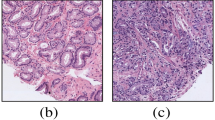Abstract
The increasing use of whole slide digital scanners has led to an enormous interest in the application of machine learning techniques to detect prostate cancer using eosin and hematoxylin stained histopathological images. In this work the above problem is approached as follows: the optical density of each whole slide image is calculated and its eosin and hematoxylin concentration components estimated. Then, hand-crafted features, which are expected to capture the expertise of pathologists, are extracted from patches of these two concentration components. Finally, patches are classified using a Deep Gaussian Process on the extracted features. The new approach outperforms current state of the art shallow as well as deep classifiers like InceptionV3, Xception and VGG19 with an AUC value higher than 0.98.
This work was supported by the Spanish Ministry of Economy and Competitiveness through project DPI2016-77869.
Access this chapter
Tax calculation will be finalised at checkout
Purchases are for personal use only
Similar content being viewed by others
References
Guo, Z., Zhang, L., Zhang, D.: Rotation invariant texture classification using LBP variance (LBPV) with global matching. Pattern Recogn. 43(3), 706–719 (2010)
Kandemir, M., Zhang, C., Hamprecht, F.A.: Empowering multiple instance histopathology cancer diagnosis by cell graphs. In: Golland, P., Hata, N., Barillot, C., Hornegger, J., Howe, R. (eds.) MICCAI 2014. LNCS, vol. 8674, pp. 228–235. Springer, Cham (2014). https://doi.org/10.1007/978-3-319-10470-6_29
Komura, D., Ishikawa, S.: Machine learning methods for histopathological image analysis. Comput. Struct. Biotechnol. J. 16, 34–42 (2018)
Litjens, G., et al.: Deep learning as a tool for increased accuracy and efficiency of histopathological diagnosis. Sci. Rep. 6, 26286 (2016)
Pietikäinen, M., Hadid, A., Zhao, G., Ahonen, T.: Computer Vision Using Local Binary Patterns. Springer, Heidelberg (2011). https://doi.org/10.1007/978-0-85729-748-8
Ruifrok, A.C., Johnston, D.A.: Quantification of histochemical staining by color deconvolution. Anal. Quant. Cytol. Histol. 23(4), 291–299 (2001)
Salimbeni, H., Deisenroth, M.: Doubly stochastic variational inference for deep Gaussian processes. In: NIPS, pp. 4591–4602 (2017)
Siegel, R.L., Miller, K.D., Jemal, A.: Cancer statistics. CA Cancer J. Clin. 68(1), 7–30 (2018)
Author information
Authors and Affiliations
Corresponding author
Editor information
Editors and Affiliations
Rights and permissions
Copyright information
© 2019 Springer Nature Switzerland AG
About this paper
Cite this paper
López-Pérez, M., Colomer, A., Sales, M.A., Molina, R., Naranjo, V. (2019). Classifying Prostate Histological Images Using Deep Gaussian Processes on a New Optical Density Granulometry-Based Descriptor. In: Yin, H., Camacho, D., Tino, P., Tallón-Ballesteros, A., Menezes, R., Allmendinger, R. (eds) Intelligent Data Engineering and Automated Learning – IDEAL 2019. IDEAL 2019. Lecture Notes in Computer Science(), vol 11871. Springer, Cham. https://doi.org/10.1007/978-3-030-33607-3_5
Download citation
DOI: https://doi.org/10.1007/978-3-030-33607-3_5
Published:
Publisher Name: Springer, Cham
Print ISBN: 978-3-030-33606-6
Online ISBN: 978-3-030-33607-3
eBook Packages: Computer ScienceComputer Science (R0)




